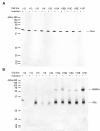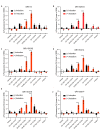A Sex Pheromone Receptor in the Hessian Fly Mayetiola destructor (Diptera, Cecidomyiidae)
- PMID: 27656130
- PMCID: PMC5013046
- DOI: 10.3389/fncel.2016.00212
A Sex Pheromone Receptor in the Hessian Fly Mayetiola destructor (Diptera, Cecidomyiidae)
Abstract
The Hessian fly, Mayetiola destructor Say (Diptera, Cecidomyiidae), is a pest of wheat and belongs to a group of gall-inducing herbivores. This species has a unique life history and several ecological features that differentiate it from other Diptera such as Drosophila melanogaster and blood-feeding mosquitoes. These features include a short, non-feeding adult life stage (1-2 days) and the use of a long-range sex pheromone produced and released by adult females. Sex pheromones are detected by members of the odorant receptor (OR) family within the Lepidoptera, but no receptors for similar long-range sex pheromones have been characterized from the Diptera. Previously, 122 OR genes have been annotated from the Hessian fly genome, with many of them showing sex-biased expression in the antennae. Here we have expressed, in HEK293 cells, five MdesORs that display male-biased expression in antennae, and we have identified MdesOR115 as a Hessian fly sex pheromone receptor. MdesOR115 responds primarily to the sex pheromone component (2S,8E,10E)-8,10-tridecadien-2-yl acetate, and secondarily to the corresponding Z,E-isomer. Certain sensory neuron membrane proteins (i.e., SNMP1) are important for responses of pheromone receptors in flies and moths. The Hessian fly genome is unusual in that it encodes six SNMP1 paralogs, of which five are expressed in antennae. We co-expressed each of the five antennal SNMP1 paralogs together with each of the five candidate sex pheromone receptors from the Hessian fly and found that they do not influence the response of MdesOR115, nor do they confer responsiveness in any of the non-responsive ORs to any of the sex pheromone components identified to date in the Hessian fly. Using Western blots, we detected protein expression of MdesOrco, all MdesSNMPs, and all MdesORs except for MdesOR113, potentially explaining the lack of response from this OR. In conclusion, we report the first functional characterization of an OR from the Cecidomyiidae, extending the role of ORs as long-range sex pheromone detectors from the Lepidoptera into the Diptera.
Keywords: HEK293 cells; deorphanization; functional characterization; heterologous expression; odorant receptor; pheromone receptor; sensory neuron membrane protein.
Figures




References
-
- Andersson M. N., Grosse-Wilde E., Keeling C. I., Bengtsson J. M., Yuen M. M., Li M., et al. (2013). Antennal transcriptome analysis of the chemosensory gene families in the tree killing bark beetles, Ips typographus and Dendroctonus ponderosae (Coleoptera: Curculionidae: Scolytinae). BMC Genomics 14:198 10.1186/1471-2164-14-198 - DOI - PMC - PubMed
-
- Andersson M. N., Löfstedt C., Newcomb R. D. (2015). Insect olfaction and the evolution of receptor tuning. Front. Ecol. Evol. 3:53 10.3389/fevo.2015.00053 - DOI
LinkOut - more resources
Full Text Sources
Other Literature Sources

